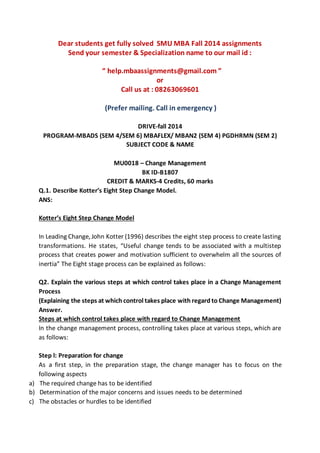
Mu0018 – change management
- 1. Dear students get fully solved SMU MBA Fall 2014 assignments Send your semester & Specialization name to our mail id : “ help.mbaassignments@gmail.com ” or Call us at : 08263069601 (Prefer mailing. Call in emergency ) DRIVE-fall 2014 PROGRAM-MBADS (SEM 4/SEM 6) MBAFLEX/ MBAN2 (SEM 4) PGDHRMN (SEM 2) SUBJECT CODE & NAME MU0018 – Change Management BK ID-B1807 CREDIT & MARKS-4 Credits, 60 marks Q.1. Describe Kotter’s Eight Step Change Model. ANS: Kotter’s Eight Step Change Model In Leading Change, John Kotter (1996) describes the eight step process to create lasting transformations. He states, “Useful change tends to be associated with a multistep process that creates power and motivation sufficient to overwhelm all the sources of inertia” The Eight stage process can be explained as follows: Q2. Explain the various steps at which control takes place in a Change Management Process (Explaining the steps at which control takes place with regard to Change Management) Answer. Steps at which control takes place with regard to Change Management In the change management process, controlling takes place at various steps, which are as follows: Step l: Preparation for change As a first step, in the preparation stage, the change manager has to focus on the following aspects a) The required change has to be identified b) Determination of the major concerns and issues needs to be determined c) The obstacles or hurdles to be identified
- 2. d) Calculating the involvement of risk and determination of the cost of change e) Understanding the reasons for resisting the change (a) A suitable method to be devised recognizing the requirement for change and identification of the present position Q3.What do you mean by Organizational Effectiveness? Explain the approaches involved in achieving Organizational Effectiveness (Definition of Organizational Effectiveness, Explain the approaches to achieve Organizational effectiveness) Answer. Organizational Effectiveness Organizational effectiveness is the concept of how effective an organization is in achieving theoutcomes theorganization intends to produce. The idea of organizational effectiveness is especially important for non-profit organizations as most people who donate money to nonprofit organizations and charities are interested in knowing whether the organization is effective in accomplishing its goals. Organizational effectiveness has been defined as thedegree of goal achievement. The determination of an organization’s goal(s) is crucial in evaluatingeffectiveness of an organization. Thefirst step in the determination of goals is to distinguish between official and operative goals. Q4. Define organizational Culture. Describe briefly about the types of organizational Culture (Definition of Culture, Explaining the various types of organizational culture) 2, 8 Answer. Culture The word ‘culture’ has been derived metaphorically from the idea of ‘cultivation’, the process of tilling and developing land. When we talk about culture, we are typically referring to the pattern of development reflected in a society’s system of knowledge, ideology, values, laws, social norms and day-to-day rituals. Organizational culture is said to be a blend of innovation and the ability to take risks, attention to detail, outcome orientation, people orientation, team orientation, aggressiveness and stability. Q.5. Explain the Behavioural Approach to Individual Change. (Explanation of the Behavioural Approach) 10 ANS: The Behavioural Approach to Individual Change
- 3. The behavioural approach: This mainly concentrates on the diagnosing of the surface level cultures that is thebehaviours of theindividualswhich is responsible for managing the relationships in theorganisation. This is highly important for implementing the new strategies. This will compare whether the behaviours are suitable for implementing the new strategies. It helps the managers, whether the culture itself should be changed or the strategies have to be changed. The competing values approach: This focuses on how to solve the values that are in confusion. This approach has given two value pairs, which helps to understand theorganisation culture. The two value pairs are: · Internal focus and integration versus external focus and differentiation. · Flexibility and discretion versus stability and control. Q6. Write a brief note on the following: a)Kurt Lewin’s Model of change b)Burke-Litwin Model of organizational performance and change (Explaining the concept of Kurt Lewin’s model, Explaining the concept of Burke-Litwin model) 5, 5 Answer. a)Kurt Lewin’s Model of change In order to ensure that change is permanent, Kurt Lewin described the three phases of thechange process which can enable theorganization to movefrom thecurrent stateto the desired state—Unfreezing, Changing, Dear students get fully solved SMU MBA Fall 2014 assignments Send your semester & Specialization name to our mail id : “ help.mbaassignments@gmail.com ” or Call us at : 08263069601 (Prefer mailing. Call in emergency )
